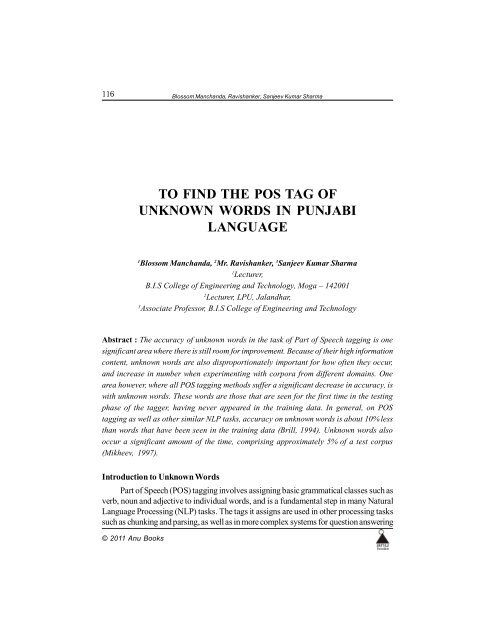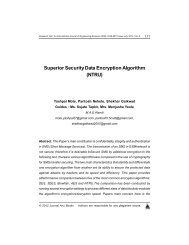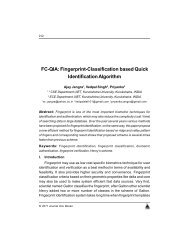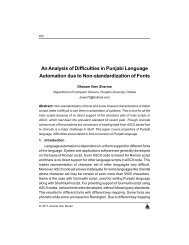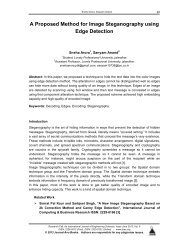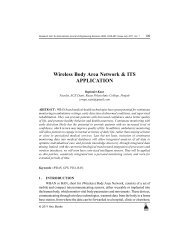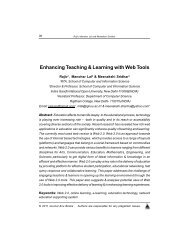To Find the POS Tag of Unknown Words in Punjabi ... - Ijoes.org
To Find the POS Tag of Unknown Words in Punjabi ... - Ijoes.org
To Find the POS Tag of Unknown Words in Punjabi ... - Ijoes.org
You also want an ePaper? Increase the reach of your titles
YUMPU automatically turns print PDFs into web optimized ePapers that Google loves.
116<br />
Blossom Manchanda, Ravishanker, Sanjeev Kumar Sharma<br />
TO FIND THE <strong>POS</strong> TAG OF<br />
UNKNOWN WORDS IN PUNJABI<br />
LANGUAGE<br />
1<br />
Blossom Manchanda, 2 Mr. Ravishanker, 3 Sanjeev Kumar Sharma<br />
1<br />
Lecturer,<br />
B.I.S College <strong>of</strong> Eng<strong>in</strong>eer<strong>in</strong>g and Technology, Moga – 142001<br />
2<br />
Lecturer, LPU, Jalandhar,<br />
3<br />
Associate Pr<strong>of</strong>essor, B.I.S College <strong>of</strong> Eng<strong>in</strong>eer<strong>in</strong>g and Technology<br />
Abstract : The accuracy <strong>of</strong> unknown words <strong>in</strong> <strong>the</strong> task <strong>of</strong> Part <strong>of</strong> Speech tagg<strong>in</strong>g is one<br />
significant area where <strong>the</strong>re is still room for improvement. Because <strong>of</strong> <strong>the</strong>ir high <strong>in</strong>formation<br />
content, unknown words are also disproportionately important for how <strong>of</strong>ten <strong>the</strong>y occur,<br />
and <strong>in</strong>crease <strong>in</strong> number when experiment<strong>in</strong>g with corpora from different doma<strong>in</strong>s. One<br />
area however, where all <strong>POS</strong> tagg<strong>in</strong>g methods suffer a significant decrease <strong>in</strong> accuracy, is<br />
with unknown words. These words are those that are seen for <strong>the</strong> first time <strong>in</strong> <strong>the</strong> test<strong>in</strong>g<br />
phase <strong>of</strong> <strong>the</strong> tagger, hav<strong>in</strong>g never appeared <strong>in</strong> <strong>the</strong> tra<strong>in</strong><strong>in</strong>g data. In general, on <strong>POS</strong><br />
tagg<strong>in</strong>g as well as o<strong>the</strong>r similar NLP tasks, accuracy on unknown words is about 10% less<br />
than words that have been seen <strong>in</strong> <strong>the</strong> tra<strong>in</strong><strong>in</strong>g data (Brill, 1994). <strong>Unknown</strong> words also<br />
occur a significant amount <strong>of</strong> <strong>the</strong> time, compris<strong>in</strong>g approximately 5% <strong>of</strong> a test corpus<br />
(Mikheev, 1997).<br />
Introduction to <strong>Unknown</strong> <strong>Words</strong><br />
Part <strong>of</strong> Speech (<strong>POS</strong>) tagg<strong>in</strong>g <strong>in</strong>volves assign<strong>in</strong>g basic grammatical classes such as<br />
verb, noun and adjective to <strong>in</strong>dividual words, and is a fundamental step <strong>in</strong> many Natural<br />
Language Process<strong>in</strong>g (NLP) tasks. The tags it assigns are used <strong>in</strong> o<strong>the</strong>r process<strong>in</strong>g tasks<br />
such as chunk<strong>in</strong>g and pars<strong>in</strong>g, as well as <strong>in</strong> more complex systems for question answer<strong>in</strong>g<br />
© 2011 Anu Books
Research Cell: An International Journal <strong>of</strong> Eng<strong>in</strong>eer<strong>in</strong>g Sciences ISSN: 2229-6913 Issue July 2011, Vol. 1<br />
117<br />
and automatic summarisation. All <strong>POS</strong> taggers suffer a significant decrease <strong>in</strong> accuracy<br />
on unknown words, that is, words that have not been previously seen <strong>in</strong> <strong>the</strong> annotated<br />
tra<strong>in</strong><strong>in</strong>g set. A loss <strong>of</strong> up to 10% is typical for most <strong>POS</strong> taggers e.g. Brill (1994) and<br />
Ratnaparkhi (1996)[1]. This decreased accuracy has a flow on effect for <strong>the</strong> accuracy<br />
<strong>of</strong> both follow<strong>in</strong>g <strong>POS</strong> tags and later processes which utilize <strong>the</strong>m. <strong>Unknown</strong> words also<br />
occur a significant amount <strong>of</strong> <strong>the</strong> time, rang<strong>in</strong>g from 2%– 5%(Mikheev, 1997), depend<strong>in</strong>g<br />
on <strong>the</strong> tra<strong>in</strong><strong>in</strong>g and test corpus. These figures are much higher for doma<strong>in</strong>s with large<br />
specialist vocabularies, for example biological text. We improve <strong>the</strong> performance <strong>of</strong> a<br />
Maximum Entropy <strong>POS</strong> tagger by implement<strong>in</strong>g features with non-negative real values.<br />
Although Maximum Entropy is typically described assum<strong>in</strong>g b<strong>in</strong>ary-valued features, <strong>the</strong>y<br />
are not <strong>in</strong> fact required to be b<strong>in</strong>ary valued. The only limitations come from <strong>the</strong> optimization<br />
algorithm. For example, <strong>the</strong> Generalised Iterative Scal<strong>in</strong>g (Darroch and Ratcliff, 1972)<br />
algorithm used <strong>in</strong> <strong>the</strong>se experiments imposes a non-negativity constra<strong>in</strong>t on feature values.<br />
Real-valued features can encapsulate contextual <strong>in</strong>formation extracted from around<br />
unknown word occurrences <strong>in</strong> an unannotated corpus. Us<strong>in</strong>g a large corpus is important<br />
because this <strong>in</strong>creases <strong>the</strong> reliability <strong>of</strong> <strong>the</strong> real-values. By look<strong>in</strong>g at <strong>the</strong> surround<strong>in</strong>g<br />
words, we can formulate constra<strong>in</strong>ts on what <strong>POS</strong> tag(s) could be assigned. This can be<br />
seen <strong>in</strong> <strong>the</strong> sentence below:<br />
(1) pkg{i hefj zd fe g[Zso NB; aB fdb B{zeJhfpwkohnKbkfdzdhj <br />
Here, NB; aB is <strong>the</strong> unknown word (word from o<strong>the</strong>r language) which, as competent<br />
speakers <strong>of</strong> <strong>the</strong> language, we can surmise is probably a noun or adjective. This is because<br />
it sits between two nouns, which is a position frequently assumed by words with <strong>the</strong>se<br />
syntactic categories. Also, if we can f<strong>in</strong>d <strong>the</strong> word NB; aB <strong>in</strong> o<strong>the</strong>r places, <strong>the</strong>n we can get<br />
an even better, more reliable idea <strong>of</strong> what its correct tag should be. S<strong>in</strong>ce we see it so<br />
<strong>of</strong>ten, we know <strong>the</strong> types <strong>of</strong> words that follow it quite well. O<strong>the</strong>r words that occur less<br />
frequently don’t give as strong an <strong>in</strong>dication <strong>of</strong> what is to follow, simply because <strong>the</strong><br />
evidence is sparser. Our aim <strong>the</strong>n, is to take this <strong>in</strong>tuitive reason<strong>in</strong>g for determ<strong>in</strong><strong>in</strong>g <strong>the</strong><br />
correct tag for an unknown word.<br />
<strong>Unknown</strong> word process<strong>in</strong>g<br />
<strong>POS</strong> taggers have reached such a high degree <strong>of</strong> accuracy that <strong>the</strong>re rema<strong>in</strong><br />
few areas where performance can be improved significantly. <strong>Unknown</strong> words<br />
are one <strong>of</strong> <strong>the</strong>se areas, with state-<strong>of</strong>-<strong>the</strong>-art accuracy <strong>in</strong> <strong>the</strong> range 85 – 88%,<br />
which is well below <strong>the</strong> 97% accuracy achievable over all words. The prevalence <strong>of</strong><br />
unknown words is also problematic, although somewhat dependant on <strong>the</strong> size and type<br />
<strong>of</strong> corpus be<strong>in</strong>g used. Rports shows that tra<strong>in</strong><strong>in</strong>g on sections 0–18 <strong>of</strong> <strong>the</strong> Penn Treebank<br />
(Marcus et al., 1993), and test on sections 22–24. This test set <strong>the</strong>n conta<strong>in</strong>s 2.81%<br />
(approximately 4000) unknown words. Also, when apply<strong>in</strong>g a <strong>POS</strong> tagger to a specialized<br />
© 2011 Anu Books
118<br />
Blossom Manchanda, Ravishanker, Sanjeev Kumar Sharma<br />
area <strong>of</strong> text, such as technical papers, <strong>the</strong> number <strong>of</strong> unknown words and <strong>the</strong>ir frequency<br />
would be expected to <strong>in</strong>crease dramatically, due to specific jargon terms be<strong>in</strong>g used.<br />
<strong>Unknown</strong> words are also more likely to carry a greater semantic significance than known<br />
words <strong>in</strong> a sentence. That is, <strong>the</strong>y will <strong>of</strong>ten conta<strong>in</strong> a larger amount <strong>of</strong> <strong>the</strong> content <strong>of</strong> <strong>the</strong><br />
sentence than o<strong>the</strong>r words. This is because unknown words are unlikely to be from<br />
closed-class categories such as determ<strong>in</strong>ers and prepositions, but quite likely to be <strong>in</strong><br />
open class categories such as nouns and verbs. It is <strong>the</strong>se classes that generally convey<br />
most <strong>of</strong> <strong>the</strong> <strong>in</strong>formation <strong>in</strong> a sentence. Fur<strong>the</strong>r, rarer words <strong>of</strong>ten have a more specialized<br />
mean<strong>in</strong>g, and <strong>the</strong>reby classify<strong>in</strong>g <strong>the</strong>m <strong>in</strong>correctly will potentially lose a lot <strong>of</strong> <strong>in</strong>formation.<br />
For <strong>the</strong>se reasons, it is quite important that unknown words are <strong>POS</strong> tagged correctly, so<br />
that <strong>the</strong> <strong>in</strong>formation carried by <strong>the</strong>m can be extracted properly <strong>in</strong> future stages <strong>of</strong> an NLP<br />
system. Previous work on tagg<strong>in</strong>g unknown words has focused on morphological features,<br />
and us<strong>in</strong>g common affixes to better identify <strong>the</strong> correct tag. This has been done us<strong>in</strong>g<br />
manually created, common English end<strong>in</strong>gs (Weischedel et al., 1993), with Transformation<br />
Based Learn<strong>in</strong>g (TBL) (Brill, 1994), and by compar<strong>in</strong>g pairs <strong>of</strong> words <strong>in</strong> a lexicon for<br />
differences <strong>in</strong> <strong>the</strong>ir beg<strong>in</strong>n<strong>in</strong>gs and end<strong>in</strong>gs (Mikheev, 1997). There is no such work has<br />
been done for <strong>Punjabi</strong> Language.<br />
The Trigram Model<br />
It is assumed that <strong>the</strong> unknown <strong>POS</strong> depends on <strong>the</strong> previous two <strong>POS</strong> tags, and<br />
calculate <strong>the</strong> trigram probability P(t3|t1, t2), where t3 stands for <strong>the</strong> unknown <strong>POS</strong>, and<br />
t1 and t2 stand for <strong>the</strong> two previous <strong>POS</strong> tags. The <strong>POS</strong> tags for known words are taken<br />
from <strong>the</strong> tagged tra<strong>in</strong><strong>in</strong>g corpus. Similarly we can also calculate <strong>the</strong> <strong>POS</strong> tag <strong>of</strong> unknown<br />
word if we know <strong>the</strong> <strong>POS</strong> tag <strong>of</strong> previous and <strong>the</strong> next word <strong>of</strong> unknown words are<br />
known to us. Ano<strong>the</strong>r similar way is us<strong>in</strong>g <strong>the</strong> <strong>POS</strong> tag <strong>of</strong> next two tags <strong>in</strong>stead <strong>of</strong><br />
previous two tags. So we used all <strong>the</strong>se three methods <strong>in</strong> three different situations.<br />
Case 1: If <strong>the</strong> <strong>POS</strong> tag <strong>of</strong> previous and next word to unknown is known to us, <strong>the</strong>n<br />
we will calculate <strong>the</strong> trigram probability P(t3|t1, t2), where t3 stands for <strong>the</strong> unknown<br />
<strong>POS</strong>, and t1 and t2 stand for <strong>the</strong> previous and next word <strong>POS</strong> tags respectively.<br />
Case 2: If <strong>the</strong> <strong>POS</strong> tag <strong>of</strong> previous word to unknown word is unknown which<br />
means previous word is also a unknown word, <strong>the</strong>n we will calculate <strong>the</strong> trigram probability<br />
P(t3|t1, t2), where t3 stands for <strong>the</strong> unknown <strong>POS</strong>, and t1 and t2 stand for <strong>the</strong> <strong>POS</strong> tags<br />
<strong>of</strong> next two words.<br />
Case 3: If <strong>the</strong> <strong>POS</strong> tag <strong>of</strong> next word to unknown word is unknown which<br />
means next word is also a unknown word, <strong>the</strong>n we will calculate <strong>the</strong> trigram<br />
probability P(t3|t1, t2), where t3 stands for <strong>the</strong> unknown <strong>POS</strong>, and t1 and t2 stand<br />
for <strong>the</strong> <strong>POS</strong> tags <strong>of</strong> previous two words.<br />
© 2011 Anu Books
Research Cell: An International Journal <strong>of</strong> Eng<strong>in</strong>eer<strong>in</strong>g Sciences ISSN: 2229-6913 Issue July 2011, Vol. 1<br />
119<br />
Now <strong>in</strong> order to calculate <strong>the</strong> trigram probability an annotated corpus was<br />
developed. This corpus was collected from different web sites by keep<strong>in</strong>g <strong>in</strong> m<strong>in</strong>d<br />
that all <strong>the</strong> common doma<strong>in</strong>s should be covered. Then this corpus was tagged by<br />
us<strong>in</strong>g a pre exist<strong>in</strong>g rule based <strong>POS</strong> tagger. This pre exist<strong>in</strong>g <strong>POS</strong> tagger uses 630<br />
tags which covers almost all <strong>the</strong> word classes with <strong>the</strong>ir <strong>in</strong>flections. This tra<strong>in</strong>ed<br />
<strong>POS</strong> tag was divided <strong>in</strong> to two different corpuses, one conta<strong>in</strong><strong>in</strong>g <strong>the</strong> sentences<br />
without any unknown word and <strong>the</strong> o<strong>the</strong>r conta<strong>in</strong><strong>in</strong>g <strong>the</strong> sentences that conta<strong>in</strong><br />
unknown words. The corpus that does not conta<strong>in</strong> any unknown word was used<br />
for tra<strong>in</strong><strong>in</strong>g <strong>the</strong> model and <strong>the</strong> o<strong>the</strong>r portion that conta<strong>in</strong>s unknown words was<br />
used for test<strong>in</strong>g.<br />
Collection <strong>of</strong> corpus<br />
The basic need for us<strong>in</strong>g <strong>the</strong> statistical methods/techniques is <strong>the</strong> availability <strong>of</strong><br />
annotated corpus. More <strong>the</strong> corpus available more will be <strong>the</strong> accuracy. Ano<strong>the</strong>r th<strong>in</strong>g<br />
© 2011 Anu Books
120<br />
Blossom Manchanda, Ravishanker, Sanjeev Kumar Sharma<br />
that should be kept <strong>in</strong> m<strong>in</strong>d is that <strong>the</strong> corpus should be accurate. So we started our<br />
work with <strong>the</strong> collection <strong>of</strong> accurate corpus. While collect<strong>in</strong>g <strong>the</strong> corpus we kept <strong>the</strong><br />
follow<strong>in</strong>g po<strong>in</strong>ts <strong>in</strong> our m<strong>in</strong>d:-<br />
• The corpus should be <strong>in</strong> Unicode.<br />
• The corpus should be accurate i.e. it should have m<strong>in</strong>imum no <strong>of</strong> spell<strong>in</strong>g<br />
mistake.<br />
• The corpus should not be doma<strong>in</strong> specific.<br />
• The corpus should conta<strong>in</strong> as many different words as possible.<br />
The ma<strong>in</strong> sources <strong>of</strong> our corpus are:-<br />
http://punjabikhabar.blogspot.com<br />
http://www.quamiekta.com<br />
http://www.europediawaz.com<br />
http://www.charhdikala.com<br />
http://punjabitribuneonl<strong>in</strong>e.com<br />
http://www.sadachannel.com<br />
www.veerpunjab.com<br />
www.punjab<strong>in</strong>fol<strong>in</strong>e.com<br />
Annotation <strong>of</strong> <strong>the</strong> corpus<br />
Annotation <strong>of</strong> <strong>the</strong> corpus means giv<strong>in</strong>g a tag to <strong>the</strong> every <strong>in</strong>dividual word. The<br />
next step that we performed after <strong>the</strong> collection <strong>of</strong> corpus was to annotate <strong>the</strong> corpus.<br />
We annotate <strong>the</strong> corpus by us<strong>in</strong>g a tool named TAGGER. This tool is developed by us.<br />
This tool has been developed from a pre exist<strong>in</strong>g Rule based <strong>POS</strong> <strong>Tag</strong>ger. We made<br />
some alteration <strong>in</strong> that pre exist<strong>in</strong>g tool and used it for <strong>the</strong> annotation <strong>of</strong> our corpus.<br />
Screen<strong>in</strong>g/Filter<strong>in</strong>g <strong>of</strong> annotated corpus<br />
As <strong>the</strong> annotated corpus conta<strong>in</strong>s many words hav<strong>in</strong>g ambiguous tags i.e. <strong>the</strong><br />
words hav<strong>in</strong>g more than one tag, so we filtered <strong>the</strong> sentence that conta<strong>in</strong>s ambiguous<br />
words. In this way we divided <strong>the</strong> annotated corpus <strong>in</strong> two parts, one conta<strong>in</strong><strong>in</strong>g <strong>the</strong><br />
sentences that have ambiguous words and <strong>the</strong> o<strong>the</strong>r that does not conta<strong>in</strong> any sentence<br />
hav<strong>in</strong>g ambiguous word. After this first filter<strong>in</strong>g we applied ano<strong>the</strong>r type <strong>of</strong> filter<strong>in</strong>g.<br />
From <strong>the</strong> annotated corpus that does not conta<strong>in</strong> any ambiguous word we separate <strong>the</strong><br />
sentence that does not conta<strong>in</strong> unknown words.<br />
© 2011 Anu Books
Research Cell: An International Journal <strong>of</strong> Eng<strong>in</strong>eer<strong>in</strong>g Sciences ISSN: 2229-6913 Issue July 2011, Vol. 1<br />
121<br />
Creat<strong>in</strong>g Triplets with frequency<br />
From <strong>the</strong> corpus that does not conta<strong>in</strong> any unknown word we created <strong>the</strong><br />
triplets <strong>of</strong> pos tags. After creat<strong>in</strong>g triplets we calculate <strong>the</strong>ir frequency <strong>of</strong> occurrence<br />
<strong>in</strong> <strong>the</strong> corpus.<br />
Results and Discussion<br />
We divide <strong>the</strong> test<strong>in</strong>g corpus <strong>in</strong> to four parts <strong>of</strong> equal length. These four equal<br />
parts conta<strong>in</strong>s different no <strong>of</strong> unknown words. We get <strong>the</strong> follow<strong>in</strong>g results:<br />
© 2011 Anu Books
122<br />
Blossom Manchanda, Ravishanker, Sanjeev Kumar Sharma<br />
The reason for not tagg<strong>in</strong>g <strong>the</strong> unknown word is absence <strong>of</strong> <strong>the</strong> triplet with<br />
that comb<strong>in</strong>ation. Most <strong>of</strong> <strong>the</strong> untagged unknown words are <strong>of</strong> similar type. The<br />
<strong>in</strong>correct tags <strong>of</strong> unknown words can be fur<strong>the</strong>r reduced by select<strong>in</strong>g two highest<br />
frequency triplets satisfy<strong>in</strong>g <strong>the</strong> condition. Suppose we have a word ft b/B <strong>in</strong> follow<strong>in</strong>g<br />
sentence:<br />
fJ; fcabwd/nzs ft Zu ft b/B B{zfg; s"b Bkba; a{NeoB dhpi kJ/i afj o d/e/wkfonki Kdkj .<br />
(fJ; _PNDBSO fcabw_NNFSO d/_PPIDAMSO nzs_NNMSO ft Zu_PPIBSD<br />
ft b/B_<strong>Unknown</strong> Bz{_PPUNU fg; s"b_<strong>Unknown</strong> Bkb_AVU ; a{N_NNFSD eoB_NNMSO<br />
dh_PPIDAFSO pi kJ/_PPU i afj o_NNMSO d/_PPIDAMSO e/_PPIMPD<br />
wkfonk_VBMAMSXXPTNIA i Kdk_VBOPMSXXXINDA j _VBAXBST1<br />
. _Sentence )<br />
In above sentence ft b/B is unknown word.<br />
When we search for <strong>the</strong> triplet<br />
PPIBSD _<strong>Unknown</strong> _PPUNU<br />
We get many comb<strong>in</strong>ations with different frequencies but <strong>the</strong> two highest<br />
frequencies are<br />
PPIBSD _NNMSO_PPUNU 54<br />
PPIBSD _NNFSO_PPUNU 48<br />
So <strong>in</strong>stead <strong>of</strong> replac<strong>in</strong>g <strong>Unknown</strong> with NNMSO (with highest frequency 54)<br />
we prefer replace <strong>Unknown</strong> with NNMSO/NNFSO. Fur<strong>the</strong>r <strong>the</strong> <strong>POS</strong> tagger will<br />
resolve this ambiguity.<br />
© 2011 Anu Books
Research Cell: An International Journal <strong>of</strong> Eng<strong>in</strong>eer<strong>in</strong>g Sciences ISSN: 2229-6913 Issue July 2011, Vol. 1<br />
123<br />
References:<br />
[1] Adwait Ratnaparkhi, (1996) “A Maximum Entropy Model for Parts-<strong>of</strong>-Speech<br />
<strong>Tag</strong>g<strong>in</strong>g”, 1-7.<br />
[2] Chooi-L<strong>in</strong>g GOH, Masayuki ASAHARA, Yuji MATSUMOTO, (2004)<br />
“Prun<strong>in</strong>g False <strong>Unknown</strong> <strong>Words</strong> to Improve Ch<strong>in</strong>ese Word Segmentation”139-<br />
148.<br />
[3] Huihs<strong>in</strong> Tseng, Daniel Jurafsky, Christopher, (2005) “Morphologcal features<br />
help <strong>POS</strong> tagg<strong>in</strong>g <strong>of</strong> unknown words across language varieties”, 1-8.<br />
[4] Ilya Segalovich, (2006) “A fast morphological algorithm with unknown word<br />
guess<strong>in</strong>g <strong>in</strong>duced by a dictionary for a web search” 3-4<br />
[5] Shulamit Umansky-Pens<strong>in</strong>, Roi Reihart, Ari Rappoport, (2010) “A Multi<br />
Doma<strong>in</strong> Web Based Algorithm for <strong>POS</strong> <strong>Tag</strong>g<strong>in</strong>g <strong>of</strong> <strong>Unknown</strong> <strong>Words</strong>”, 1-9.<br />
[6] Tetsuji Nakagawa, Taku Kudoh, Yuji Matsumoto, (2001) “<strong>Unknown</strong><br />
Word Guess<strong>in</strong>g And Part-<strong>of</strong>-Speech <strong>Tag</strong>g<strong>in</strong>g us<strong>in</strong>g Support Vector Mach<strong>in</strong>es”,<br />
1-7.<br />
[7] Tetsuji Nakagawa, Yuji Matsumoto, (2006) “Guess<strong>in</strong>g Parts <strong>of</strong> Speech <strong>of</strong><br />
<strong>Unknown</strong> <strong>Words</strong> us<strong>in</strong>g Global Information”, 1-8.<br />
[8] Xia<strong>of</strong>ei Lu, (2005), “Hybrid Methods for <strong>POS</strong> Guess<strong>in</strong>g Of Ch<strong>in</strong>ese <strong>Unknown</strong><br />
<strong>Words</strong>”, 1-6.<br />
© 2011 Anu Books


